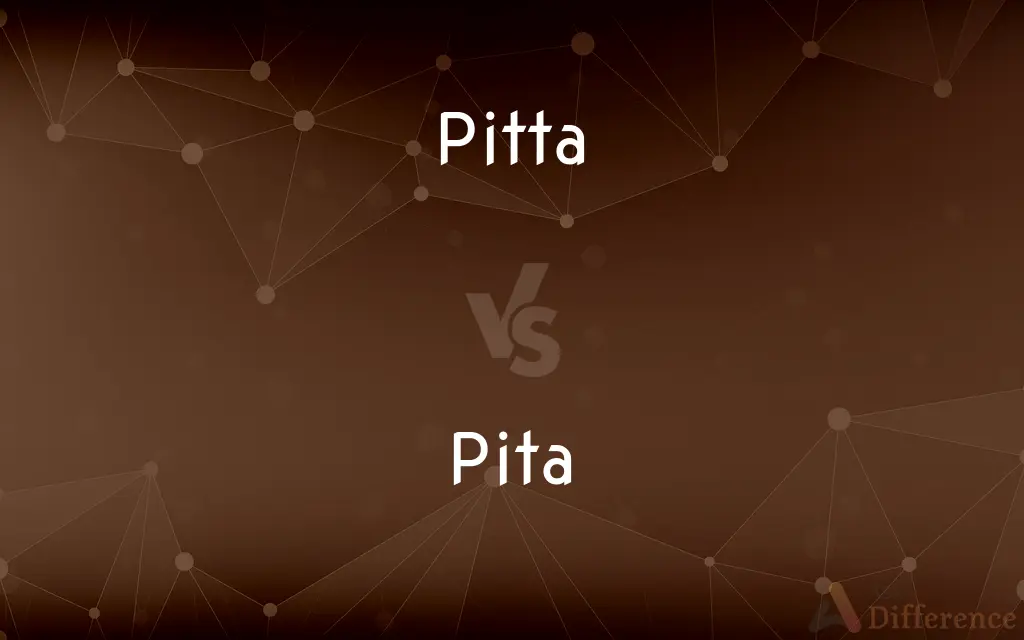Pitta vs. Pita — What's the Difference?
Edited by Tayyaba Rehman — By Urooj Arif — Updated on April 8, 2024
Pitta refers to a concept in Ayurvedic medicine representing a body energy related to digestion and metabolism, while pita is a type of flatbread from Mediterranean and Middle Eastern cuisines.

Difference Between Pitta and Pita
Table of Contents
ADVERTISEMENT
Key Differences
Pitta, in the realm of Ayurveda, is one of the three doshas or life forces, symbolizing the fire element in the body. It governs metabolic processes, body temperature, digestion, and the ability to break down foods into nutrients. Whereas, pita bread is a culinary staple, known for its pocket that can be stuffed with various fillings, playing a vital role in many dishes across Mediterranean and Middle Eastern cultures.
The concept of pitta emphasizes the balance of bodily energies for optimal health and well-being, focusing on dietary choices, lifestyle habits, and herbal treatments to maintain or restore this balance. On the other hand, pita bread's significance lies in its versatility and function in cuisine, serving as a vessel for a variety of ingredients, enhancing flavor and satisfaction.
Pitta imbalance is believed to cause health issues such as indigestion, inflammation, and excessive heat in the body, with recommendations for cooling and balancing foods to counteract these effects. In contrast, pita bread can be part of various dietary patterns, its health impact depending more on the overall eating habits and what it is paired with.
In Ayurvedic practices, understanding one's predominant dosha, including pitta, is crucial for personalized health advice, aiming to achieve a harmonious state of physical and mental health. Pita bread, reflecting the rich culinary traditions of its regions of origin, showcases the diversity of human food culture and the communal aspect of meal-sharing.
Despite their vastly different contexts—pitta in traditional Indian medicine and pita in global cuisines—both terms reflect the importance of balance, whether in bodily energies for health or in flavors and nutrition in food.
ADVERTISEMENT
Comparison Chart
Definition
A dosha in Ayurveda representing fire and water, linked to digestion and metabolism.
A type of leavened flatbread from Mediterranean and Middle Eastern cuisines.
Context
Ayurvedic medicine
Culinary, specifically Mediterranean and Middle Eastern cuisines
Primary Concern
Balance of body energies for health
Culinary versatility and nutrition
Health Focus
Digestion, metabolism, body temperature
Depends on dietary context and fillings
Cultural Origin
Indian traditional medicine
Mediterranean and Middle Eastern cuisines
Role in Diet
Diagnostic tool for personalized health advice
Dietary staple, often part of meals
Compare with Definitions
Pitta
Related to energy and transformation.
Pitta imbalance can lead to inflammation and irritability.
Pita
Known for its soft, fluffy texture.
Fresh pita bread is prized for its softness and warmth.
Pitta
Symbolizes fire in the body.
Spicy foods can aggravate pitta due to their heating qualities.
Pita
Part of Mediterranean and Middle Eastern diets.
Hummus and pita is a popular snack in many cultures.
Pitta
Integral to Ayurvedic health practices.
Ayurveda recommends specific practices to maintain pitta balance for health.
Pita
Can be used in a variety of dishes.
Pita chips are made by baking or frying pita slices until crispy.
Pitta
Governed by dietary and lifestyle habits.
Consuming cooling foods like cucumbers can help balance pitta.
Pita
A type of flatbread with a pocket.
Pita bread is often filled with grilled meats and vegetables.
Pitta
A dosha focused on metabolism and digestion.
Balancing pitta is essential for individuals with high metabolic heat.
Pita
Reflects communal eating traditions.
Sharing a meal of pita and dips is common in family gatherings.
Pitta
Pittas are a family, Pittidae, of passerine birds found in Asia, Australasia and Africa. There are thought to be 40 to 42 species of pittas, all similar in general appearance and habits.
Pita
Pita ( or US: ) or pitta (British English), is a family of yeast-leavened round flatbreads baked from wheat flour, common in the Mediterranean, Middle East, and neighboring areas. It includes the widely known version with an interior pocket, also known as Arabic bread (Arabic: khubz ʿarabī), Syrian bread and other names, as well as pocketless versions such as the Greek pita, used to wrap souvlaki.
Pitta
Any of several brightly colored passerine birds of the genus Pitta that live in forests of Asia, Australia, and Africa and have a strong bill, a short tail, and long legs.
Pita
A round flat bread of Middle Eastern origin that can be opened to form a pocket for filling. Also called pocket bread.
Pitta
Any passerine belonging to the taxonomic family Pittidae.
Pita
Any of several agaves that yield strong leaf fibers. Also called istle.
Pitta
Any one of a large group of bright-colored clamatorial birds belonging to Pitta, and allied genera of the family Pittidæ. Most of the species are varied with three or more colors, such as blue, green, crimson, yellow, purple, and black. They are called also ground thrushes, and Old World ant thrushes; but they are not related to the true thrushes.
Pita
The fiber of any of these plants, used in making cordage and paper.
Pitta
Any bird of the genus Pitta; brilliantly colored chiefly terrestrial birds with short wings and tail and stout bills
Pita
A flat bread pouch used for making sandwiches such as gyros or falafels.
Pita
A fiber obtained from the Agave americana and related species, used for making cordage and paper.
Pita
The plant which yields the fiber.
Pita
A fiber obtained from the Agave Americana and other related species, - used for making cordage and paper. Called also pita fiber, and pita thread.
Pita
Usually small round bread that can open into a pocket for filling
Common Curiosities
What is pita bread?
Pita bread is a type of leavened flatbread from Mediterranean and Middle Eastern cuisines, known for its pocket.
What is pitta?
Pitta is one of the three doshas in Ayurveda, associated with fire and water elements, governing metabolism and digestion.
Can adjusting pitta balance affect overall well-being?
Yes, balancing pitta through diet and lifestyle is believed to improve digestion, energy levels, and overall health.
How does pitta affect health according to Ayurveda?
Pitta governs digestion and metabolism; its imbalance can cause issues like inflammation and indigestion.
What are signs of a pitta imbalance?
Signs include excessive heat, sweating, irritability, and digestive issues like heartburn.
Can everyone follow a pitta-balancing diet?
While beneficial for those with a pitta constitution, others should balance dietary choices according to their dosha.
How do Ayurvedic principles personalize dietary advice?
Ayurveda considers individual doshic imbalances to recommend specific foods and lifestyle adjustments for health.
Is pita bread healthy?
Pita bread can be part of a healthy diet, especially when whole grain and served with nutrient-rich fillings.
Are there different types of pita bread?
Yes, variations include whole wheat pita, white pita, and versions with herbs or spices baked in.
Can pita bread be homemade?
Yes, pita bread can be made at home with basic baking ingredients and a hot oven for puffing up.
What foods are commonly served with pita?
Pita is often served with dips such as hummus, stuffed with meats or vegetables, or used to make sandwiches.
How can one balance pitta?
Cooling foods, avoiding excessive heat, and managing stress can help balance pitta.
Is pita bread vegan?
Most pita breads are vegan, containing basic ingredients like flour, water, yeast, and salt, but recipes can vary.
How is pita served in traditional cuisines?
Traditionally, pita is served warm, often as an accompaniment to dips, kebabs, or as a wrap for various fillings.
What lifestyle changes can balance pitta?
Adopting a cooling and calming routine, including moderate exercise and stress reduction, can balance pitta.
Share Your Discovery

Previous Comparison
Sux vs. Sax
Next Comparison
Proxy vs. RepresentativeAuthor Spotlight
Written by
Urooj ArifUrooj is a skilled content writer at Ask Difference, known for her exceptional ability to simplify complex topics into engaging and informative content. With a passion for research and a flair for clear, concise writing, she consistently delivers articles that resonate with our diverse audience.
Edited by
Tayyaba RehmanTayyaba Rehman is a distinguished writer, currently serving as a primary contributor to askdifference.com. As a researcher in semantics and etymology, Tayyaba's passion for the complexity of languages and their distinctions has found a perfect home on the platform. Tayyaba delves into the intricacies of language, distinguishing between commonly confused words and phrases, thereby providing clarity for readers worldwide.















































